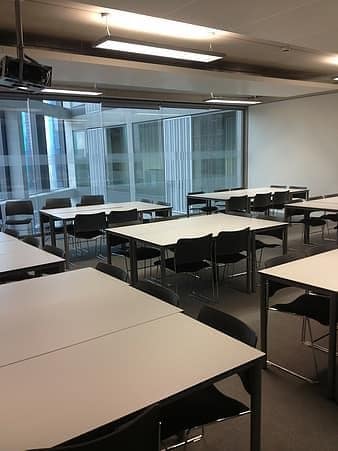Over the years, classrooms, or ‘places of learning’ have undergone many spatial iterations, and one of them is the shift to the open space learning that have shared common areas and the individual space/teacher model. It is a popular and innovative classroom design implemented at schools in many European countries to promote problem-based learning. Some of the features of these unique pedagogical methods are as follows:
- Circular sitting arrangements to ensure that no child ends up sitting in the corner and all children receive the teacher’s attention equally.
- Many brightly colored panels that let in natural light while keeping the heat out.
- A seamless fusion between work and play areas and a centralized air purification system which creates a comfortable learning environment.
- Open classroom schools have large spaces for immersive learning and dedicated small hubs for individual assistance.
- Training and experience of teachers and the design around acoustics also play a significant role in delivering successful and sustainable learning outcomes.
What is the impact of this change in the learning environment?
The learning outcomes are most likely to get realized through diversified learning activities and innovative learning spaces. In this context, some schools in India have now introduced open space learning. The objective here is to minimize rote learning and teach the traditional curriculum experimentally to enable children to learn life and career skills at an early age. The open classroom schools help fulfill these objectives through architectural interventions, other than utilizing child-centric learning methodologies.
In this hybrid approach, wider central corridors have been replaced with informal, interactive learning spaces in and outside the classroom. The goal is to facilitate quiet and loud learning, both with and without peers.
These changes in the structure, design, and seating arrangement in the classroom also redefine the teachers’ role. They are no longer the dispenser of knowledge, but the facilitators of learning. No student ends up feeling left out, nor the teacher feels isolated from the students despite being with them. Overall, it gets easier for the teacher to manage the classroom and plan activities that includes students with different learning abilities. This way, learning becomes an activity that is child-centric rather than teacher-oriented.
Besides, the course content is delivered based on the students’ needs and not just the standard checklists prescribed for each grade. The performances of the students are not quantified through rankings, which measure success in a competition-based context. Instead, progress is evaluated in terms of a student’s improvement and growth with respect to the past performances. Further, a sense of ownership and responsibility, as demonstrated in academic and related arts areas, are also considered.
Open space learning classrooms emerge as interest centers where children get a chance to dabble into topical activities. This helps promote the discovery-through-experimentation method, a precedent to constructivism. Learners are encouraged to explore, practice, and develop their interests to facilitate understanding of a new concept through scientific methods.
Class composition and seating arrangement in open classroom schools resemble a one-room schoolhouse. Students are more or less allowed to move around in the class freely. By training, teachers are prepared to be mindful of the individual needs and maintain fluid group membership. This ensures that they work towards promoting diversity and teamwork in the class.
Are all these claims evidence-based?
The straightforward answer to this question is yes. Let’s take a look at the two oft-cited studies on this topic. A study comprising a class of fourth-graders in Germany (Marx, Fuhrer & Hartig, 1999) examined whether a change in the pattern of seating arrangements led to increased student participation; for example, more questions being asked. They tried two seating arrangements – traditional rows and columns and a semicircle. For eight weeks, the researchers observed 53 German and maths lessons. The teacher was at the front – either sitting at her desk or standing—during each class that was observed.
The results showed that the children asked more questions when seated in the semi-circular arrangement compared to the row-and-column arrangement. The researchers also observed that arranging seats in a semicircle in a primary school ‘could lead to equal opportunities for everyone in the class,’ but simultaneously emphasized the teacher’s participation, personality, and teaching style as factors that affect student participation.
Research in psychology undertaken by Amanda Careena Fernandes, Jinyan Huang, Vince J. Rinaldo in 2011 also showed that involvement, sense of belonging, and engagement promote better learning among students. As explained in the study, ‘classroom participation is associated with the generation and promotion of higher-order thinking skills, and this cognitive stimulation provides students with a different environment which promotes positive and effective learning experiences …’.
The education structure is shifting towards more hands-on experience with an emphasis on problem-based learning. Do you wish for your kid to be ahead of the times? Enrol your kid in an open-space learning school and notice the differences.













